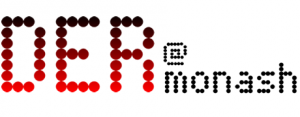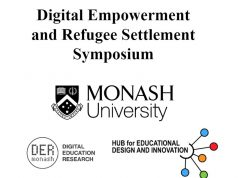Author:
Michael Henderson
There is a fundamental crisis that the digital technology teaching and research community face: the dominance of stories about what we do with technology rather than what we are trying to achieve.
I suggest that a scan of conferences and journal articles largely supports my concern of the dominance of descriptions of our activity (what we did and the outcomes we saw) rather than depth of analysis (the nature of the problem and how the outcomes relate). This is in alignment with our recent review of the use of theory within educational technology and media research. This survey of 462 active researchers revealed a disconcerting low rate of purposeful use of theory (35%), compounded with a confusion of what constituted theory versus a field of study (Bulfin, Henderson & Johnson, 2013). The conclusion is that the majority of the researchers in that study rely on descriptive measures to explain their goals and their findings. The problem is that while a need or problem can be described, it cannot be assumed to be understood, nor designed for, unless its complexity is interrogated. Without such clarity the goals cannot be clearly identified, the criteria for success become difficult to justify, and ultimately the design cannot be tested. By focussing on how we use the technology seriously risks our capacity to explain the fundamental value and demonstrate the impact of our highly visible work with technology.
From the outside it might appear that the field is populated with naïve practitioners and researchers. On the contrary, in my experience, the problems and the complexity of the social, pedagogical and broader educational contexts are palpable in the ‘coffee pot’ conversations outside of the conference presentation and in staffrooms. It is perhaps both a strength and weakness in our field that we are such optimists, that we choose to share what we find useful, rather than dwell on what was ‘wicked’. The optimistic pragmatism of academics and practitioners is a defining characteristic of the educational technology community of practice.
However, as a community of practitioners and academics in the field of education and technology, we are in the unique position of being able to bring together nuanced understandings of technology, practice, and theory. This is a challenge in itself, and it is not aided by the popular discourse surrounding “technology solutions”. We all know that technology does not solve things, although it can aid in satisfying our educational passions or needs. It comes with additional layers of complexity that go beyond simple technical barriers or hurdles.
For example, we have all heard the hype about using social media spaces, such as wikis, blogs, twitter or even Facebook for students and their teachers to collaborate on tasks. Leaving aside regulatory, ethical, technical and pedagogical implications, we have a fundamental problem in that our education system, its policies, curriculum, practices and normative values centre on individualised assessment. Student progression, cultural beliefs around success, and not least our university entrance scores are predicated on individualized grading within a competitive environment. As a consequence, as has been shown in our literature review of research on social media in schools, the effective use of wikis for collaboration, for co-dependent and creative risk taking, cannot be achieved by simply adding the technology, nor is it as simple as teaching students how to use a wiki (Henderson, Snyder & Beale, 2013).
Even if we could imagine a technology that fitted what Larry Cuban would call the grammar of schooling, the differences between teachers, students, classes, and schools means that a technology cannot be easily transplanted from one location to the next.
For example, we have all experienced the frustration of trying to understand why some teachers adopt, adapt or reject technology practices. My own research has demonstrated that simply adding technology does not result in success, and furthermore, that teacher professional learning is intimately connected with their identities, which are built up over time and cannot simply be change by some technical training (Henderson, 2008). Professional learning is more than training. For example, it has been demonstrated that learning events and networks are more likely to shape teacher practice when they help us to more centripetally engage in a community of practice, and thereby shape our identity so we can see in different ways. However, Communities of Practice resist design and teacher identities cannot be predictably changed. At best, we have an idea of how we could begin the process.
The uniqueness of every context means that innovation needs to be re-designed in every school, classroom and professional learning activity. So long as we celebrate what we do with technology we will attract criticisms of “reinventing the wheel,” whereas, if we highlight the unique problems we are resolving then we are re-affirming the innovative nature of what we do.
Bringing technology to bear to meet educational needs is complicated: it is a “wicked problem”.
The term ‘wicked problem’ has been attributed to Rittel and Webber in the early 70s relating to social policy. They distinguished it from “tame” problems such as found in chess. The term “wicked” is used to denote resistance to resolution, rather than something more sinister. The problem is not the technology, which is a finite and ultimately manageable system. Instead, I contend that the “wicked problem” lies in the sheer complexity of education, not least the diversity of teachers, teaching, students, learning, policy and schools. A wicked problem is one that is essentially unresolvable, or as Rittel and Webber stated “At best they are only re-solved over and over again” (Rittel & Webber, 1973, p. 160). By casting educational technology, or perhaps more accurately the tension between education and technology, as a wicked problem, it helps to explain why innovations cannot be simply replicated, nor outcomes guaranteed.
Educational technology research, policy and initiatives are ultimately undermined unless we celebrate the wicked nature of the problem. By doing so we can more boldly engage with the growing criticisms of the impact of technology in schools and higher education. In celebrating such complexity we also find potential new ways to tackle the problem, explain our goals and measure our success. One such approach is the pragmatic optimism of design thinking (for example, see Carroll, et al., 2010). Our task then is to recognise the “wicked problem”, and innovate with what I call, “wicked designs”. In doing so we highlight the complexity, and affirm that we are generating ways to engage with the problem, without falling into the distraction of seeking “solutions”.
By talking about wicked designs, we can continue to optimistically and pragmatically direct our attention to finding new ways to use educational technology to meet learning needs. However, what needs to become explicit is the unique complexity of the context, the iterative nature of what we are setting out to do, and the ultimately irresolvable nature of the problem itself.
About the author:
Dr Michael Henderson is a member of the LNM group and a senior lecturer in Educational Technology in the Faculty of Education, Monash. His profile can be found here.
Twitter: @mjhenderson
Featured image source: https://www.flickr.com/photos/sagesolar/10501009176/
Article Published: 23rd October, 2014
References
Carroll, M., Goldman, S., Britos, L., Koh, J., Royalty, A., & Hornstein, M. (2010). Destination, imagination and the fires within: Design thinking in a middle school classroom. International Journal of Art & Design Education, 29(1), 37-53.http://web.stanford.edu/group/redlab/cgi-bin/materials/IJADE_Article.pdf
Henderson, M. (2008). Relationships are more important than content: designing effective Professional Development within a Community of Practice approach. Proceedings of the Society for Information Technology Education Conference 2008. Las Vegas: AACE.
Henderson, M., Snyder, I., & Beale, D. (2013). Social media for collaborative learning: A review of school literature. Australian Educational Computing, 28 (2), pp. 1-15. Available at: http://journal.acce.edu.au/index.php/AEC/article/view/18
Rittel, H. W. J., & Webber, M. M. (1973). Dilemmas in a General Theory of Planning. Policy Sciences, 4, 155-169.
Scott Bulfin , Michael Henderson & Nicola Johnson (2013) Examining the use of theory within educational technology and media research, Learning, Media and Technology, 38:3, 337-344, DOI: 10.1080/17439884.2013.790315







